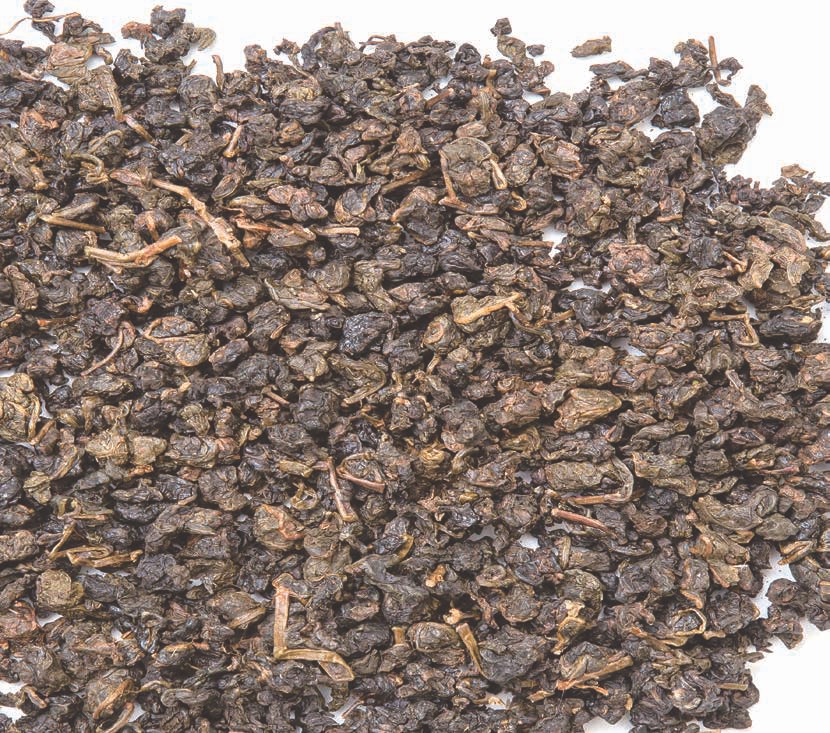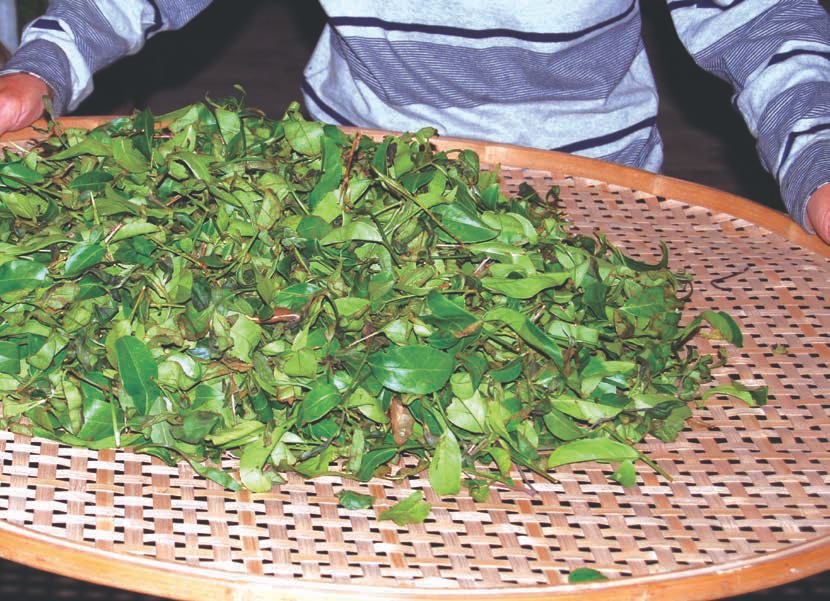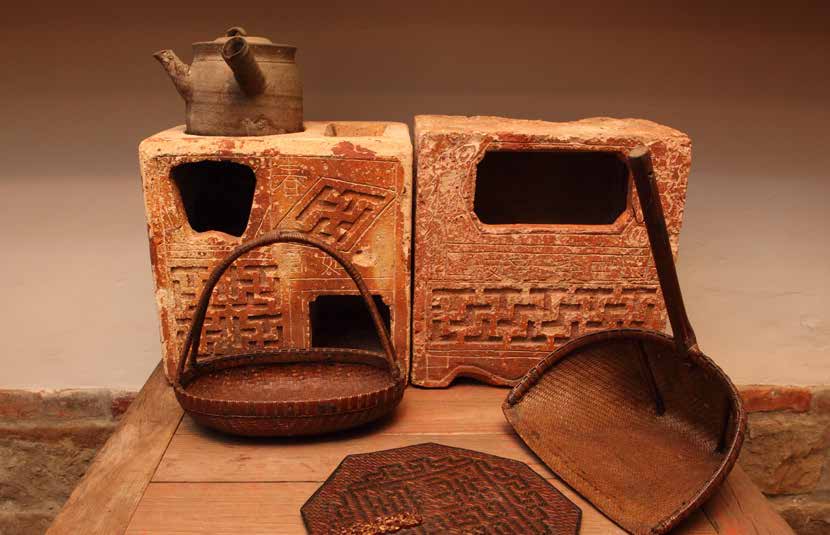
 |
|


Oolong is the richest and most refined of tea chests, filled with so many varieties and kinds of tea that you couldn't explore them all in a lifetime. It is technically defined by the fact that it is semi-oxidized, but that barely sketches an outline of this huge genre of tea - especially since "semi-oxidized" can mean everything from ten to seventy percent. When you add to that all the different mountains oolong tea comes from, the varietals of trees and variations in processing you have a huge map, spanning Taiwan, Chaozhou and Fujian mostly. We'd truly need the "black dragon" this tea is named after to fly through the rich heritage, history and variety of oolong. But what a journey that would be!
When talking about genres of tea, it is always important to remember that the typical understanding that "all tea is one plant and the differences are in the processing" can be very misleading, indeed. There is some truth in that statement, but authors who use it rarely qualify it as much as they should.
Different processing methodologies were developed regionally over 3 time and are as much a part of the terroir as the rain, sun or soil composition. And these regional variations in processing grew alongside certain varietals of tea. The masters that lived and worked with these leaves were listening to them, and that conversation was often responsible for the evolution of any given processing methodology. In other words, oolong processing was developed over time to suit certain varietals of tea because that is what brought out their greatest potential. The farmers mastered their craft by processing the tea the way it "wanted" to be - for lack of a better word, we use "want" to describe the nature of the tea. Just as water "wants" to flow downhill, these leaves wanted to be oolong. In that way, oolong is as much in the varietals of tea as it is in the processing. And that is true for most of the other seven genres of tea, as well (Red and Black teas can be exceptions to this rule, but not always). While you could process tea leaves from Wuyi mountain like a green tea or an artificially fermented black tea (not red!), they would not be nearly as good as green tea from such a varietal or Liu Bao black tea. Furthermore, they wouldn't be as nice as the oolong made from the same leaves!
And this evolution continues on in every tea growing season, even now. If you travel to Wuyi, for example, and watch a true master make oolong tea each year, you would see a lot of variation from year to year. The overall methodology used to describe oolong production is as general and rough a sketch for what actually happens as any basic understanding of an artistic process is. In any art, the basic formula is always a very abstract and simplified explanation of what the practitioner knows much more intimately, subtly and with complex discrepancies. Similarly, when a beginner watches a master brew gongfu tea, he or she tries to grasp the basic steps of pre-warming the cups, showering the pot, steeping the tea, showering the pot again, and so forth. But to the master, there are great and very important subtleties that change these steps from tea to tea, like how high you pour water into the pot from, which is different for different teas.
The master farmers are changing the way they make tea each and every season. Everything from when they pick - what day and which time of day - to how long they fire the tea to de-enzyme it will change based on the weather and season and how the tea looks and feels to them. This means that their processing must suit their trees and terroir; not just in terms of some fixed methodology, but rather a changing and adaptable process that, like any skill, requires them to intuit and then modify their processing to suit the current leaves. In that way, also, oolong is as much the terroir and trees as it is the processing methods.
Oolong tea involves the most sophisticated and complicated of all tea production, requiring the greatest skill that can refine or ruin a tea. Each kind of tea measures its quality in some ratio of these three factors:
With puerh tea, for example, the quality is almost exclusively in the first of these: - the trees and the environment. When producing a fine oolong, however, all three are equally important. It's not enough to have great trees in a nice environment, for the complicated processing will have as much to say as Nature. These is true of all teas, as a manifestation of Heaven, Earth and Man energies, but none as profoundly so as oolong tea.
Oolong tea gets its name from an old folktale about a lazy son who was nicknamed "Black Dragon" because he was always so tan from falling asleep in the tea fields during the day. Though he was a great hunter, his father didn't seem to notice. After so many poor harvests, the old man had had enough and told Black Dragon to come home with a full basket or not at all! Black Dragon was clever, though, and worked vigorously to fill his basket with tea leaves by midday so he could take a nap. After some time, he saw a rabbit and chased it down, forgetting that his basket was still strapped to his back. When he got home, he discovered that half the leaves had flown out in the pursuit. His father was furious and kicked him out of the house.
Several days later, the elders of the village came to see the old father, saying that the tea he brought in that day was the best they'd ever tasted. They all went to the forest to find Black Dragon and ask him where he'd gotten the tea. When he showed them that it had come from the same trees it always came from, they were confused. They asked him to tell them everything that had happened that day. One of the wiser elders quickly realized that the difference in the tea had something to do with Black Dragon chasing the rabbit. After some experimentation, they realized that it was the result of shaking the leaves on his back, which bruised the edges of the leaves and furthered their oxidation.
From that day, all their tea was named after its founder, who became one of the village chiefs. And even now, all oolong tea is shaken during the withering to bruise the leaves red around the edges!
The basic steps that make up all oolong production are harvesting, withering/shaking, de-enzyming, rolling and roasting. But these steps are a part of most all tea production. What really sets oolong apart is the withering. Because oolong is a semi-oxidized tea, it is withered in a very particular way - both indoors and outdoors. Oolong is mostly withered on big, round bamboo trays that are stacked on shelves, allowing for airflow underneath. But production in larger quantities, as well as a movement towards more modern production methodology means that it is also often withered on large tarps outside on the ground. As we discussed earlier, there are infinite subtle variables in the withering of fine oolong tea. (We have even seen a master lick his 5/ Buddha's Palm Oolong thumb to feel the humidity during indoor withering, and then ask his sons to bring a can full of burning charcoal to place in the back right corner of the room since he felt the humidity was too high there.)
During the withering, oolong tea is also shaken. This shaking is the most distinctive feature of oolong tea processing. It helps to bruise the cells and further the oxidation of the tea. When you see a master pick up one of the big round trays and dance the leaves around with grace, you may think that it looks easy - until you try it and toss all the leaves onto the ground (or in your face). Like all stages of fine tea, this too takes great skill. The best shaking will just bruise the cells at the edges of the leaf, which will be apparent when you brew the tea. When the shaking is done masterfully, there is a redness only at the edges of the tea, all around each leaf. Nowadays, most stages of tea processing are done with machines (in a world of quantity over quality). The shaking is done in a large machine that turns around on an axis and tumbles the tea, bruising it, but not with the precision that a master can do by hand.
Oolong tea is either ball-shaped or striped, depending on how it is rolled. The rolling is done to further break down the cells in the leaf and to shape the tea as well. Striped teas are rolled flat across large, ridged bamboo mats. Ball-shaped oolongs, on the other hand, are rolled in twisted-up bags. You can tell a lot about a tea by looking at the shape of the balls or stripes. Hand-processed teas, for example, will have a variety of shapes, sizes and twists in the balls or stripes, whereas machine-processed tea will be much more uniform.

After withering/shaking, the second most important part of oolong processing is the roast. If a farmer is roasting the tea, they will usually just roast the tea dry - to arrest oxidation and stop the processing - until all the tea is finished that year. They don't have the time to keep up with all the tea coming in, and rarely sleep during harvests. After the picking and initial processing of maocha is done, they will then roast the tea slowly and with care, knowing this is one of the most crucial stages in the production of fine oolong tea.
Traditionally, all oolong tea had higher oxidation and roast than what you see these days. The range of oxidation that defined the genre of oolong was much smaller for the first few hundred years of its development. Most old-timers can't stand the lightly-oxidized, greener teas that are popular these days. Some say that "if it looks like a green tea and smells like a green tea, then, well..." That trend began in Taiwan in the late 1970's, or more predominantly in the 1980's. And the shift towards greener oolong was also to do with terroir and varietal.
As we discussed in previous issues, the majority of Taiwanese oolong tea is produced from Qing Shin trees, which were brought to Taiwan from Wuyi. They are very sensitive trees, which get sick easily. As Taiwan started to develop infrastructure, culture and prosperity in the 1970's, tea culture grew in popularity and farming started to increase, with a trend of moving towards higher altitudes where Qing Shin trees thrive. Higher altitude farms receive less sunlight, and the tea leaves therefore respond well to such light oxidation. Again, the innovations in processing were a result of changes in terroir. This can't be stated enough, especially since so many authors mistakenly promote the idea that all tea is one plant and that the differences in kinds of tea are just based on the arbitrary decisions made by farmers who choose to process their tea as white, red, black, oolong, etc. And if you are reading between the lines, as good teawayfarers, you can perhaps see the more profound truth hiding between the rows of tea trees: there is no tea tree by itself.
Saying that there is no such thing as a tea tree in itself seems obvious to state, but necessary. We so often forget to connect the dots, because our rational mind is all about dissection and analysis, fragmentation and exploration of conceptually cut-up parts. There is no tea tree. Not really. Tea is an environment. Tea is the soil, the weather, the water, rocks and mountain. Oolong tea is not a formula in a textbook. (Show me a farmer that uses a textbook to process his tea!) Neither is it in the leaves alone. Oolong tea is a certain terroir, one that includes a particular processing methodology that suits the environment, trees and leaves of that place. It is also the culture and heritage that has developed, refined and passed on that processing wisdom from generation to generation.
And so you can understand how traditionalists might not see tea in such simple categories as "oolong", especially when the whole industry has so radically transformed in a single generation.
Generally speaking, we find that most tea lovers will slowly migrate towards deeper, darker and more full-bodied teas over time. That doesn't mean we don't enjoy a lightly-roasted oolong now and again. They can be spectacular! But a nice roasted oolong, like this month's, at the height of winter can change your day, and maybe even your week. And even if you find yourself in warmer climes, like our brothers and sisters down in Australia and New Zealand, you'll still find that a nice oolong like this month's in the late afternoon is great. Raise a cup, sending the rest of us some of that warmth! There is a lot of magic in this month's cup. We can't wait to start brewing this tea together, for what better way to start the year than a really fine tea that heralds many more to come?
This month's tea is a Buddha's Palm (Fo Shou, 佛手) oolong from Pinglin county, Taiwan. It was roasted and then donated by one of our teachers, Master Lu Li Zhen. Later on in this issue, we'll introduce Master Lu and tea roasting, as they are both topics important enough to warrant their own articles
Our tea is from this winter, so it's fresh. Taiwan often has a smaller, winter harvest, which produces teas with less vibrancy than the spring, but with a subtle and refined character. While most of Master Lu's teas would be oxidized to a traditional level of around forty percent, the weather this year was too rainy, so this year's Buddha Palm is only oxidized to around thirty percent. Ideally, to produce fine oolong, you want lots of rain, followed by a week or so of nice weather, resulting in a bit less water content in the leaves.
Master Lu roasted this tea for sixty hours continuously to bring out the nutty, fruity and lasting floral notes. It is a very fine tea, with a deep and lasting minty-coolness on the breath (hui gan, 回甘) and a satisfying warmth that makes it perfect for this time of year. You'll be able to tell that this tea was master-roasted even before you add water. In smelling the dry leaves, take long and slow inhalations, paying attention to how far the smell travels into the nasal cavity. We find the aroma smooth and long-lasting, and some of us even commented that the aroma of the dried leaves already began the movement of Qi for us.
This tea is a great tea for the afternoon, with a relaxing and uplifting Qi that can open the heart. You may find yourself feeling flighty, and therefore want to ground yourself with some nice music to accompany your session. This month's tea is one of the finest and most valuable teas that has ever been donated to the Hut; and one we are so happy to begin the year with, as it feels like we're definitely getting things off to an excellent start! Maybe we can all hold our cups with closed eyes and feel the dragon slowly lifting, soaring into a new year of tea fellowship...

Because of the great skill that goes into the production of oolong tea, it was always a more expensive tea. In the south of China, a new method of tea brewing developed along with oolong, called gongfu tea. Gongfu tea brewing was created by martial artists, and was therefore inspired by much of the same Daoist philosophy that informed those practices. By brewing the tea in small pots, with small cups, these masters simultaneously preserved this valuable tea and cultivated skills and refinement, grace and fluidity that was in concordance with their worldview.
If possible, we would always recommend brewing an oolong like this gongfu, with an Yixing pot, porcelain cups, a tea boat and kettle/stove. If that isn't possible, you can adapt this tea to any method of brewing or pot/cup/bowls that you have. Don't feel like you have to brew this tea gongfu or not at all.
A general rule for brewing oolong tea is to cover the bottom of the pot like the first, freshly-fallen leaves of autumn: covering the bottom, but you can still see it. This is important because ball-shaped oolong teas really open up a lot, and they therefore need the room to do so. Remember, it is always better to start with too little and add more, than start with too much, which wastes tea. Give the tea a longer rinse, so that the balls can open a bit more before pouring. This helps ensure they won't get bunched up near the spout before they fully open. The ideal is to get all the balls to open equally and at the same time, which will produce an ethereal third through fifth steeping!

Careworn trails Up mountain passes; With a staff for a guide I never get lost. Nature chooses Where to have Tea, As the clouds discuss How long the sojourn... One last cup to decide: Should I stay here 'Neath Buddha's raised palm Or head back down And finish the laundry?
